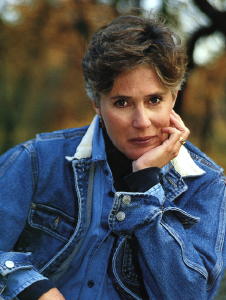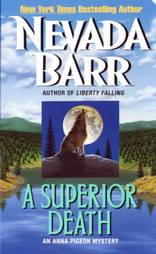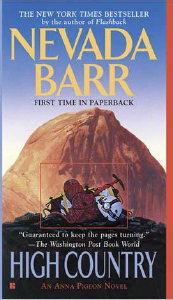|
HOBBITS IN THE NATIONAL PARKS, by Joe R.
Christopher
Nevada Barr is known, among readers of mysteries, for her novels about Anna Pigeon, a National Park Ranger whose assignments usually take her to a different national park in each book. She began in Texas, in the Guadalupe National Park, in Track of the Cat (1993). The stories are told in the third person, in a manner that easily slides from giving Pigeon’s thoughts to objective descriptions and records of conversations and actions.  As with a number of detectives, Pigeon has a literary sensibility, no doubt reflecting the authorial make-up more than that of a typical policeman (or law-enforcement ranger, in this case). But, if this sensibility is not realistic to type, it probably also reflects that of many readers – and so helps create a popularity for the books. Besides, a fictional detective is often more accomplished than the norm in various ways. Before considering Barr’s mysteries, one may start with her book of religious (or semi-religious) essays, Seeking Enlightenment . . . Hat by Hat (2003). In an essay titled “Judgment” appears this passage: [In
mentally passing
judgment on others] in the last
little while I’ve suffered a slightly bitter aftertaste, anger or
resentment of some kind. What brought this to my attention was my
spurious judgment of a beloved friend whom we shall call “Bilbo.”
(I’m reading Lord of the Rings
at the moment.) Bilbo, whom I love
dearly, is in a relationship with a woman (whom we shall call “Frodo”),
so lost in depression she is unable to think of anyone but
herself. Recently Frodo threw another self-centered fit that
spoiled a family event. Bilbo forgave her, justified her actions,
and took a lion’s share of the blame onto himself. In telling my
husband this tale, I started judging Bilbo’s actions and
motivations. As I voiced my condemnations, I grew angry with my
adored Bilbo, taking on what he and Frodo did, felt, and said as if it
had something to do with me. In fanning this kernel of anger, a
picture formed from the flames, a picture of Bilbo that was ugly.
And that hurt. (page 40, paragraphing removed)
And later: “...in reality, we don’t know why [. . .] Bilbo decided to stay in an abusive relationship or Frodo must strike out at people” (page 42, comma omitted; see also pp. 42-43). Barr offers a curious use of J. R. R. Tolkien’s subcreation — names completely out of context. But in 2002, when Barr was presumably writing her essay, and in 2001-03, when Peter Jackson’s THE LORD OF THE RINGS was appearing episodically, the names would have been familiar to her audience, even if they had not read Tolkien’s work: the use is clever and witty, enlivening her text without overwhelming it (except perhaps for a deeply serious Tolkien fan). This use of reference to Middle-Earth as an enlivening device prepares for most of the allusions that appear in the mysteries. What follows is, at least in intention and perhaps in reality, a complete survey of those references. In A Superior Death (1994), set on Isle Royale National Park (in a northern area of Lake Superior), at one point four Park Rangers have to do a “bounce dive” down to an old, deeply sunken shipwreck. (The “bounce” means in this case that they have only twenty-two minutes at the bottom.) The Tolkienian comparison occurs just after they enter the cold water of the lake. Anna Pigeon looks at one of her fellow Rangers: Tattinger
floated into
view. With the regulator stretching his
rubbery lips and the mask maximizing his watery eyes, he put Anna in
mind of Gollum, the pale underearth creature that gave Bilbo Baggins
the willies. (p. 136)
 The emphasis on Gollum’s
paleness may tie to the
first description of Jim Tattinger in the book as one who spent his
time on computers and
seldom dove the wrecks himself (p. 39) — in other words, an indoors
office
type. (His lips are also emphasized in his first description.)
With the reference to Bilbo Baggins, the description is clearly an
allusion to The Hobbit. Barr does not refer to the underground
pool by which Bilbo and Gollum spend some of their time, which would
have elaborated the comparison; but her purpose is simply to vivify the
appearance and to create suspense — if Gollum gave Bilbo “the willies,”
will (or should) Tattinger do the same to Pigeon? The emphasis on Gollum’s
paleness may tie to the
first description of Jim Tattinger in the book as one who spent his
time on computers and
seldom dove the wrecks himself (p. 39) — in other words, an indoors
office
type. (His lips are also emphasized in his first description.)
With the reference to Bilbo Baggins, the description is clearly an
allusion to The Hobbit. Barr does not refer to the underground
pool by which Bilbo and Gollum spend some of their time, which would
have elaborated the comparison; but her purpose is simply to vivify the
appearance and to create suspense — if Gollum gave Bilbo “the willies,”
will (or should) Tattinger do the same to Pigeon?In Liberty Falling (1999), Pigeon is visiting New York City because her sister is hospitalized. Pigeon stays on Liberty Island and often visits Ellis Island in this novel — that is, is involved with the Statue of Liberty and Ellis Island National Monuments — but she is in main-stream New York City (a subway train) at the time of the Tolkienian allusion. She is sitting by Frederick Stanton, an off-duty F.B.I. agent who was at one time her lover (in an earlier book) and who is now in love with her sister: Frederick
stared at his feet, long and
biblical in leather
sandals. He had hair on the tops of his toes, like a
hobbit. Anna had never noticed that before. In the
grumbling bowels of Manhattan, she found the touch of whimsy
endearing. (p. 97)
Actually, hobbits have hair on top of their feet, not just their toes; but Pigeon, as a relief from her sister’s serious illness, no doubt must find what whimsy she can. The implied surprise at not noticing Stanton’s hairy toes before only makes sense in terms of their over-three-years-earlier intimacies. But endearing is an interesting word. The suggestion is that the hobbit comparison relieves some of the tension between Pigeon and Stanton (mainly on Pigeon’s side). Stanton has been worried that she will ruin his chances to marry the sister; Pigeon has been angry at the world because of anxiety over her sister. After this Tolkienian moment, she asks Stanton to do her a favor (having to do with the mystery-novel plot) and their situation is not as tense. Hairy toes as a psychological relief. In her eighth adventure, Deep South (2000), Anna Pigeon has become a district ranger, moving to Mississippi to take the position on the Natchez Trace Parkway. Early in her time in Mississippi, she drives for half a mile from the campground where her house is located toward an edge of the Trace; the experience is set up with a description of the soil in that area of the ancient path for travel from the Nashville, Tennessee, area to the Natchez, Mississippi, area: Because
of [the soft soil called
Loess], the Old Trace [not
always
identical with the modern highway]
had worn deep in many places.
Not the two- and ten-inch ruts of the trails out in the West but
twenty — and thirty — feet deep, wide ravines cut into the forests and
swamps from the passage of horse, foot and, finally, wagon
traffic. (p. 45)
Given that background, her drive at night on a minor road (no doubt part of the 444-mile parkway built in the 1930s) is described this way: [. . .] she guessed she was passing through one
such section of the
original Trace. Walls of golden-brown dirt rose on either side of
what had suddenly become a one-lane road. Above the Crown Vic,
roots poked out from the banks. Headlights caught their
undersides, and in the light and shadow they clawed fantastic patterns
against the night. Above them, seen sketchily at the uppermost of
the high beams, were the tops of the trees they supported. The
sky was lost in the branches. Anna emerged from this hobbit’s-eye
view of the world into a small paved parking lot. (page
45,
paragraphing removed)
All of this passage is an elaborate descriptive build-up to a minor adjective: “hobbit’s-eye.” But interestingly Barr does choose to bring a hobbit into her text. Technically, she is making the reading experience slightly more vivid with a comparison. She did not, however, say “midget’s-eye view” nor “pigmy’s-eye view,” using real-life specifics. She chooses a fantasy vivifier, and expects her reader to respond to it — thus is Tolkien’s popularity when she writes. In Flashback (2003), Anna Pigeon decides to wriggle under a sunken engine — from a boat that exploded — undersea in the Dry Tortugas National Park, off the coast of Florida. This causes her to think back to her adventures in Lechuguilla Cave, a cavern not open to the general public in the Carlsbad Cavern National Park (Blind Descent, 1998). Without
her vest and tank [diving
gear] she could fit in the
crevice. It would take a bit of wriggling to keep her hand up
near her eyes so she’d have light [from a flashlight] when she reached
the [engine] number, but it
wouldn’t be that tight a squeeze.
That is, she would have been mad like Gollum, his mind
warped (as made
clear in The Lord of the Rings)
by his possession of the Ring.
She would have been living in “the labyrinths of the underworld,” as
Gollum was in The Hobbit.
Probably “running” is not accurate
about Gollum, despite his pursuit of Bilbo Baggins — certainly it is
not typical of him
in The Hobbit; “running mad”
is a cliché, and
Barr has slipped into its use. She’d been in tighter. And hated it, she reminded herself. “Hated” was the word she chose to remember from her last crawl in Lechuguilla Cave some years back. It saved her from admitting to herself how terrified she’d been, how desperately close to coming unglued and running mad through the labyrinths of the underworld, a modern metaphor for Tolkien’s Gollum. (page 163) Also metaphor seems an odd word choice for how Pigeon’s hypothetical madness would have resembled Gollum’s. Usually the metaphoric image (B) is used to clarify or vivify a real-world situation (A): “the sparks from this welding torch (A), like Gandalf’s fireworks . . .” (B). Here, within Barr’s fictional world, a hypothetical “real-world” situation (B) clarifies or vivifies an example from fantasy fiction (A): “Gandalf’s fireworks (B), like sparks from a welding torch . . .” (A). To repeat: usually the image (B) clarifies or illumes the real situation (A). Barr reverses the relationship in her phrasing: the (hypothetical) real situation (B) illumes (is “a modern metaphor for”) the fantasy (A). Odd but interesting. However, probably Barr intended the opposite result for her reader: Gollum’s situation illumes and intensifies Pigeon’s hypothetical one. Finally, not a reference to Gollum but a structural allusion. All readers of The Lord of the Rings will remember that brief moment in which Gollum almost regains his earlier self, as he looks at Frodo Baggins and Samwise Gangee sleeping in a crevice near the stairs of Cirth Ungol, which the three having been climbing: Gollum
looked at them. A strange
expression passed over his lean
hungry face. The gleam faded from his eyes, and they went dim and
grey, old and tired. [. . .] For a fleeting moment,
could one of the sleepers have seen him, they would have thought that
they beheld an old weary hobbit, shrunken by the years that had carried
him far beyond his time, beyond friends and kin, and the fields and
streams of youth, an old starved pitiable thing. (4.8)
And the readers will remember that Sam’s reaction ends Gollum’s change. A similar moment (with
important differences)
affects Tiny Bigalo, one of the villains of High Country (2004), set in
Yosemite National Park. Anna Pigeon knocks her out and retrieves
the gun Bigalo had been holding. A similar moment (with
important differences)
affects Tiny Bigalo, one of the villains of High Country (2004), set in
Yosemite National Park. Anna Pigeon knocks her out and retrieves
the gun Bigalo had been holding.In
moments Tiny regained
consciousness. For a heartbeat she was
disoriented, and in that heartbeat Anna saw a different woman, not the
heartless drug dealer with family connections who ran the Ahwahnee
dining room [her official job at Yosemite] with an iron hand, but a
small lonely woman past sixty who’s lost those she loved most in life.
Anna was unmoved. The momentary innocence of forgetfulness cleared from Tiny Bigalo’s brain. Her eyes again became hard and dark as she sat up. (page 317) Besides the moment of innocence followed by a return to a more evil self, three specific similarities exist: (1) “an [. . .] old hobbit [. . .] beyond his time” and “a [. . .] woman past sixty,” (2) “shrunken by the years” and “small,” and (3) “beyond friends and kin” and having “lost those she loved most in life.” This sort of allusion is never certain, of course; but most likely Barr drew on her knowledge of Tolkien’s work, consciously or unconsciously, as she wrote this passage in her book, with Pigeon for Sam and Bigelo for Gollum. What conclusion can a reader draw from these references to and allusion to Tolkien’s fiction? First, simply that Nevada Barr has knowledge of, and believes her readers have knowledge of, that fiction. More specifically, in the first four published of her references, Barr seems to know The Hobbit only. In two of these, the reference seems clear: in A Superior Death to Gollum as an “underearth creature” and to Bilbo; in Flashback to Gollum as crazy in “the underworld.” In the other two, the references to hobbits are fairly general: in Liberty Falling to hairy toes; in Deep South to size. Then in Seeking Enlightenment Barr says she is “reading” (not re-reading) The Lord of the Rings. Her reference there is to both Bilbo and Frodo; in High Country she seems to allude to an episode in the second volume of Tolkien’s romance. Next, Barr seems to appreciate Tolkien’s works. Her references are not depreciatory. She seems to believe, in the fiction, that references to hobbits can help the reader to react to the matter as the author intends. Admittedly, more references appear in the novels to Peter Pan than to hobbits, but Anna Pigeon was married to a New York actor — and so knows drama — in her back story; thus the Tolkienian allusions are clearer literary references, not something that ties to Pigeon’s life. Third and finally, these uses of Tolkien’s fiction are simply part of the evidence of Tolkien’s influence in unlikely literary areas. No one disputes that influence on popular culture, but specific references always help to prove the case (and proving cases is what mystery fiction is all about). Works Cited: Barr, Nevada. Blind Descent. New York: G. P. Putnam’s Sons, 1998. ---. Deep South. New York: G. P. Putnam’s Sons, 2000. ---. Flashback. New York: G. P. Putnam’s Sons, 2003. ---. High Country. New York: G. P. Putnam’s Sons, 2004. ---. Liberty Falling. New York: G. P. Putnam’s Sons, 1999. ---. Seeking Enlightment . . . Hat by Hat: A Skeptic’s Path to Religion. New York: G. P. Putnam’s Sons, 2003. ---. A Superior Death. New York: G. P. Putnam’s Sons, 1994. ---. Track of the Cat. New York: G. P. Putnam’s Sons, 1993. _____________________________________ YOUR COMMENTS ARE WELCOME. stevelewis62 (at) cox.net
Copyright © 2005 by Steve
Lewis. All rights reserved to contributors.
Return to
the Main Page.
|